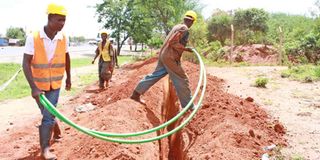Extend fiber network to rural areas and spur development

Technicians lay a fiber optic cable at Mtito Andei Town in Makueni County on November 29, 2017.
Earlier this year, Google’s parent company Alphabet announced it was shutting down Loon, a connectivity project that beamed high speed Internet to underserved areas in Kenya.
The sudden announcement came barely six months after the project was officially launched by President Uhuru Kenyatta with deployments in 14 remote counties. The low flying balloons (20 kilometres in the stratosphere) were expected to improve high speed connectivity via 4G and were touted as a game changer in the remote counties.
Coming in the middle of a pandemic where Internet Service Providers (ISPs) across the board are working to upgrade their capacity to match a spike in demand, at the very least, the success of the project would have raised awareness on what high speed connectivity contributes to the economy, and it would probably have sown seeds for other ISPs. The cancellation of an infrastructure project of this scale should be a wake-up call to technology policy makers.
Last year, Telkom Kenya said field tests undertaken on the Loon network returned uplink speeds of 4.74mbps and downlink speeds of 18.9mbps. This translates to a flawless video call and an even better internet experience.
This is not the first government intervention in connectivity – the Universal Service Fund, under the Communications Authority, has been driving the spread of mobile connectivity in the rural, sparsely populated areas that are considered economically unattractive by mobile network operators.
For the USF kitty, the CA collects 0.5 per cent of revenues from telecom service operators annually. Earlier this year, the CA said the fund has hit Sh10 billion and that new infrastructure deployments will be made later this year.
Mobile connectivity
However, the pace of USF rollout is wanting for a digital infrastructure kitty of its magnitude and responsibility. Despite the USF being set up in 2013, it was not until 2016 that the first tenders were awarded, and the second ones advertised last year.
At the same time, reports that some Tier 1 service providers have been lagging behind in their annual contributions to the kitty raises questions about the longevity of the project.
If mobile connectivity has taken this long, how about fibre connectivity to the rural areas? Covid-19 has shown us that Internet connectivity is no longer a luxury and should be treated as a utility akin to water and electricity free for access to all.
The CA and ICT ministry should work to ensure the deployment of the USF is more strategic and timely to give all Kenyans a chance to enjoy the digital inclusion the country strives for. If the USF starts planning for fibre extension to more rural areas now, maybe they will start the project next year or the following year.
Yes, the mobile connectivity project is still under way, but if people have access to the internet, there are numerous ways to make calls, access new markets, work remotely, drive businesses forward and open up new opportunities.
Fibre connectivity is not anything new to the USF team, it was well articulated in the Consultative Paper No.4/09, where all stakeholders agreed that the USF’s objective should be, among others, “Deployment of backbone transmission infrastructure like wireless and fiber in major towns and cities, and passive infrastructure (ducts, dark fiber) for rural connectivity.
Fibre connectivity
If the USF moves on to the fibre connectivity, it will open up opportunities for smaller community networks, that will further reduce connectivity costs and increase the benefits of remote work.
This does not mean that the USF is a magic pill, according to a report of the United Nations Economic and Social Commission for Asia and the Pacific — State of ICT in Asia and the Pacific 2016 — most of the USF programs in the area failed because of design, structure and implementation. For instance, the first phase of the Kenya USF implementation took more than two years, meaning even the financial disbursement was equally slow.
Design and implementation problems aside, if the USF can extend fibre connectivity and people can hold online meetings from the comfort of their rural homes, most people will be smiling and businesses will be confident that employees can work remotely.
Currently, you have to promise that the network is Ok, and that your colleagues will not keep saying; “we can’t hear you, we have lost so and so, the screen is frozen, you are breaking up, please disconnect and reconnect”.




